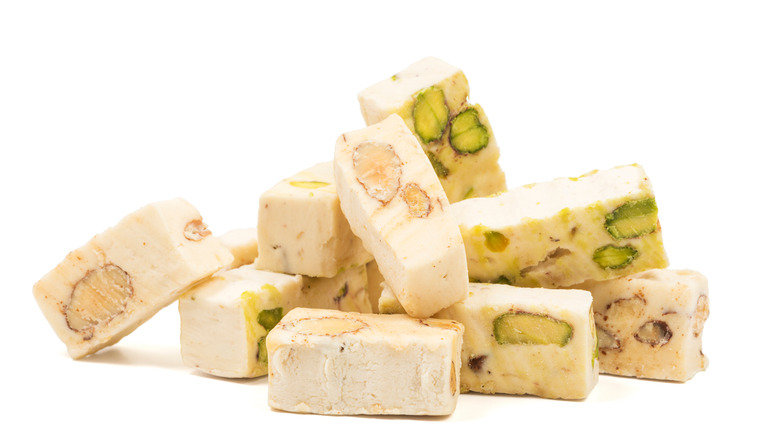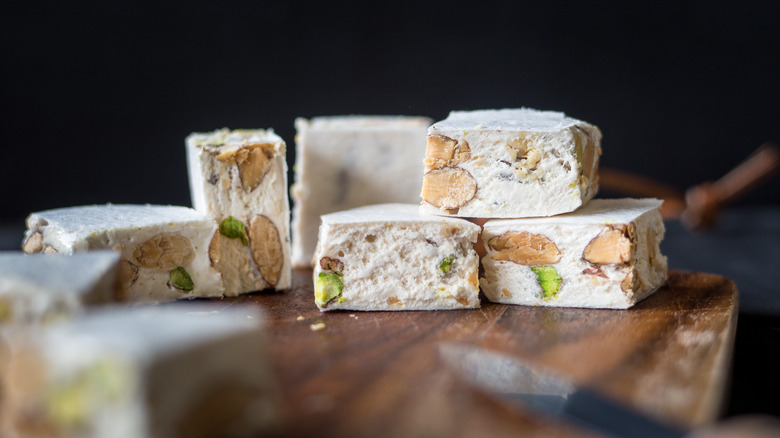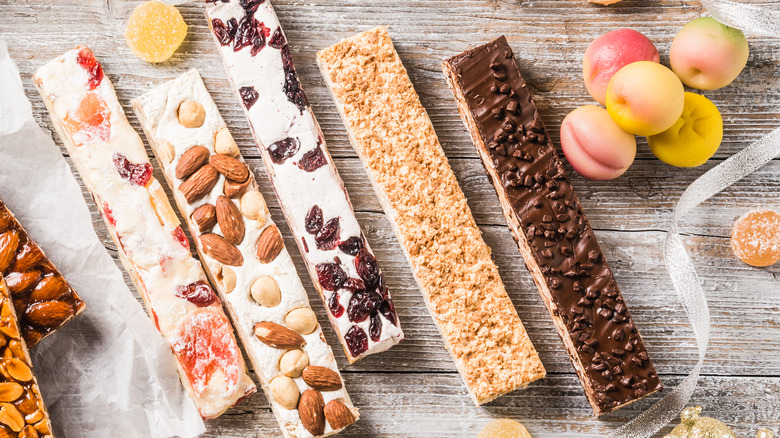Homemade Nougat Looks Nothing Like The Kind In A Candy Bar
Nougat — to know it is to love it. If you live in the U.S., you're probably only familiar with this confection as the chewy base of a Snickers bar or the crunchy nuggets studded throughout a Toblerone. But in Europe and the Middle East, you'll find different versions of nougat served as a standalone dessert. The most popular type is called white nougat — and while it can range from fluffy to tacky, or Milky Way to Toblerone, its intensely sweet, eggy flavor and memorable chewy texture is a delight in or out of candy.
White nougat, which is used to make Italian torrone and French nougat de Montélimar, always contains nuts as per the traditional recipe, and the term comes from the French word nux gatum for nut cake. Some versions of white nougat also include dried fruit. The dessert has a dense, cake-like texture with large, crunchy nut pieces and resembles a marshmallow in appearance.
How white nougat is made
The most basic white nougat recipes only call for a few ingredients — egg whites, nuts, and some form of sweetener. It sounds simple, but this short list doesn't mention one of the most important components: air. The unique texture of nougat is created by vigorously mixing and aerating the base ingredients.
Making white nougat at home starts with whipping egg whites, the same technique that you would use to make a meringue. As they're beaten, the protein molecules in egg whites unfold and capture air. Once they reach the stiff peak phase, hot syrup — either honey, sugar syrup, or corn syrup — is mixed in. The heat from the syrup cooks the egg whites, causing them to harden and lock in the air bubbles in the process. This trapped air creates the light and chewy texture of white nougat. Add-ins, like nuts, fruit, or vanilla, are stirred in after the base mixture has cooled. The nougat is then rolled out and cut into shape.
Types of nougat
White nougat is the most common variety, but it's not the only kind. There are three distinct types of nougat— white, brown, and Viennese. Although they share a name, these candies have wildly different flavors and textures.
Unlike white nougat, brown nougat doesn't begin with egg whites. Instead, the base is primarily caramelized sugar. This thick syrup doesn't trap air, and it creates a nougat with a distinctive bite. While white nougat is light and fluffy, brown nougat is dark, crunchy, and brittle. Viennese nougat, sometimes called German nougat, is distinguished by the addition of cocoa powder and cocoa butter. The added fat in this variation creates a nougat with a soft, smooth texture. Viennese nougat is often used as a filling for traditional desserts like marzipan rolls.
All three of these types of nougat can be used as a component of a dessert or enjoyed on their own. If nougat is your favorite part of every candy bar, consider skipping the Snickers and going straight to the source — pick up a torrone, or make your own version of nougat at home.


